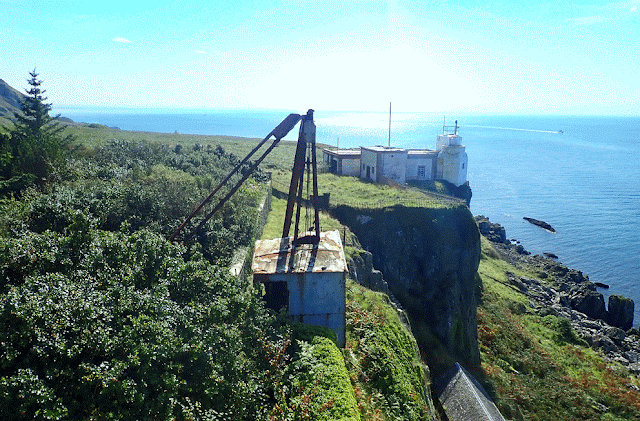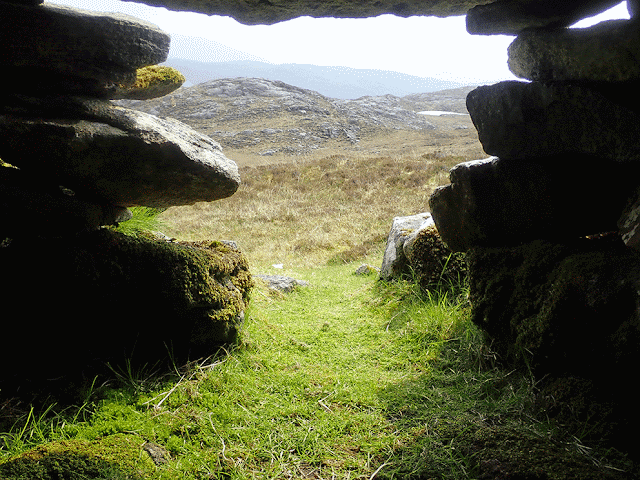After a night at anchor off Hallaig, we set a course south to transit under the Skye Bridge. That gave me a brief look at two historic sites. To port was the Eilean Ban lighthouse and cottages, made famous by Gavin Maxwell. To starboard was a lesser-known historic site, the Chain Stone of Skye. This stretch of sea has been a strategic choke point for thousands of years, as the inside passage is far easier than the long journey through the exposed waters west of Skye. When the bridge opened, there was quite a furore over the tolls. But it was not the first time tolls were collected. Centuries ago, it must have been an interesting sight when a 1000-foot-long barrier of chained logs stretched across the channel: one end securely fastened to Eilean Bàn, the other to the Chain Stone on the Skye shore.
Once through the Sound of Slate, we headed west to find an overnight anchorage in Loch Scresort of Rum. We had a few hours of shore leave before supper, so we went for a wander. Sally met up with the warden to talk ponies, and I took Debbie for the two-mile nature walk that follows an old road up the north side of Kinloch Glen. We returned to the ship after tea and a beer at the shop - I'll let you guess who had the beer. On the way back, we passed the sadly decaying Kinloch Castle. Such a waste.
We departed Loch Scresort the following morning on a quest to an island I'd wanted to visit for decades and one that Debbie also had a keen desire to see: Bac Mòr, better known as Dutchman's Cap. I first noticed the Dutchman in 1989 while on a Turas Mara day trip to Lunga. After climbing to the summit of Lunga, I saw an odd-looking island two miles to the south. It was a plug, a big hump rising out of the sea, a nearly 300-foot volcanic cone atop a grass-grown plateau of dark stone.
The island’s Gaelic name is a mix of Norse and Gaelic; Bac, Norse for ‘hump,’ and Mòr, Gaelic for big. Seen from afar, this 'big hump' looks more like a Mexican sombrero than a Dutchman’s cap. The name may have stemmed from Dutch fishermen being the first to fish in the area commercially. But Donald MacCulloch, in his book Staffa, suggests that ‘Dutchman’ may be a corruption of Doideag, Gaelic for a witch, which is a possibility, as the island's profile could be compared to that of a witch’s hat, although not as pointy as the one worn by Elphaba, the Wicked Witch of the West.
I have long wanted to set foot on Dutchman’s Cap. The main attraction was not its distinctive geology but the remains of three circular dwellings. Could they be beehive cells? Maybe, maybe not. There is also an enclosure 100 feet in diameter surrounding them—similar to a cashel. Cattle were once grazed on the island, so the enclosure and the dwellings may have been built for that purpose. But, just perhaps, they were built long ago for use as an island hermitage, as Iona lies only seven sea miles away.
Landing on the Dutchman is only possible when the tide is low and the sea is calm at a shelving ledge on the island’s east side. Approaching that spot can be dangerous. The surrounding sea is a minefield of skerries and, in places, only three feet deep at mean tide. The largest skerry is Sgeir Blàr nan Each, the skerry of the field of the horse. It is an odd name for a reef barely spanning 200 square feet at low tide. It’s hard to imagine someone putting a horse on that sea-washed reef, but that’s the name the surveyors recorded in the OS Name Book in 1878. However, on an 1859 coastal chart, it's named Sgeir Bhàirneach, barnacle skerry—which sounds like a more probable name.
After a three-hour sail, we approached the eastern side of the Dutchman. Strong winds had blown all day, and a six-foot swell lashed against the cliff-girt shore of the island. It was readily apparent we’d not be able to land. That was a disappointment, one I’ve gotten used to over the years. The engines were throttled back to give us a long look at the island. The enclosure and old dwellings are set back from the lip of the table rock and are not visible from the sea. What was visible was the massive hump that gave the island its name; stair-stepping terraces of turf encircled its lower half, a sign that grazing sheep have been here in the past. The upper half of the hump was a basaltic mantle crowned by a cylindrical trig-pillar. (The settlement site is marked with an 'x' in the following photo.
In his book Coll & Tiree (1903), Erskine Beveridge briefly mentions the Dutchman: Upon its east shoulder, below the prominent 'Cap,' the ruins of three small circular erections—probably old shielings. Bac Mor is now tenanted only by Highland cattle, as to which a local saying runs that nineteen will thrive upon this island, but twenty would starve—surely a most precise computation!
We occasionally saw the landing ledge where, per Erskine Beveridge, cattle were once set ashore. Our sightings of the ledge were brief because the rolling sea repeatedly washed over it. Even if the sea is calm, there is no place to anchor, so the chances of landing are always slim. In Islands by the Score, Alasdair Alpin MacGregor commented as follows on the suggestion that the ruins on the Dutchman were shielings: Could these be the ruins of summer shieling visited by the Lunga folk in olden times, as has been suggested? What would seem to render this unlikely is the fact that, even on the calmest days, it would be impossible either to land cows, alive, on this island, or to get them off, alive, at the end of shieling-time.
As for MacGregor’s comment that it would be impossible to land cattle on the island, per Erskine Beverage, as many as nineteen were pastured there. But the sea state we witnessed on that September day would make it impossible to land people, let alone cattle. A landing on the Dutchman would have to wait for another time. A private charter out of Tobermory or Ulva Ferry would be the best way—an adventure for the future.
Before leaving, we passed the skerry of two names: Sgeir Blàr nan Each/Sgeir Bhàirneach. There were no horses on the reef, and if there were any barnacles they were covered by the roiling surf. We also took a look at Bac Beag (on the left in the next photo). Bac Beag is the 'little hump', which at low tide is connected to the Dutchman. This little hump is actually humpless—a flat table of basalt rising fifty feet above the sea.
Leaving the Dutchman in our wake, we set a course for the shelter of Lon Bhearnuis, a bay on the north coast of Ulva.
After settling into the bunk that night, I set the alarm for 3 a.m. When it sounded, I was hesitant to abandon the warm bed. But then I remembered that the heavens were calling. Trying not to wake anyone, I went up on deck as quietly as possible. It was a clear night, the hills of Mull and Ulva glimmering under the light of a full moon. Several others joined me from the ship’s company, and together, we watched the moon dim as Dubhadh Gealaich, the lunar eclipse, began.

























































